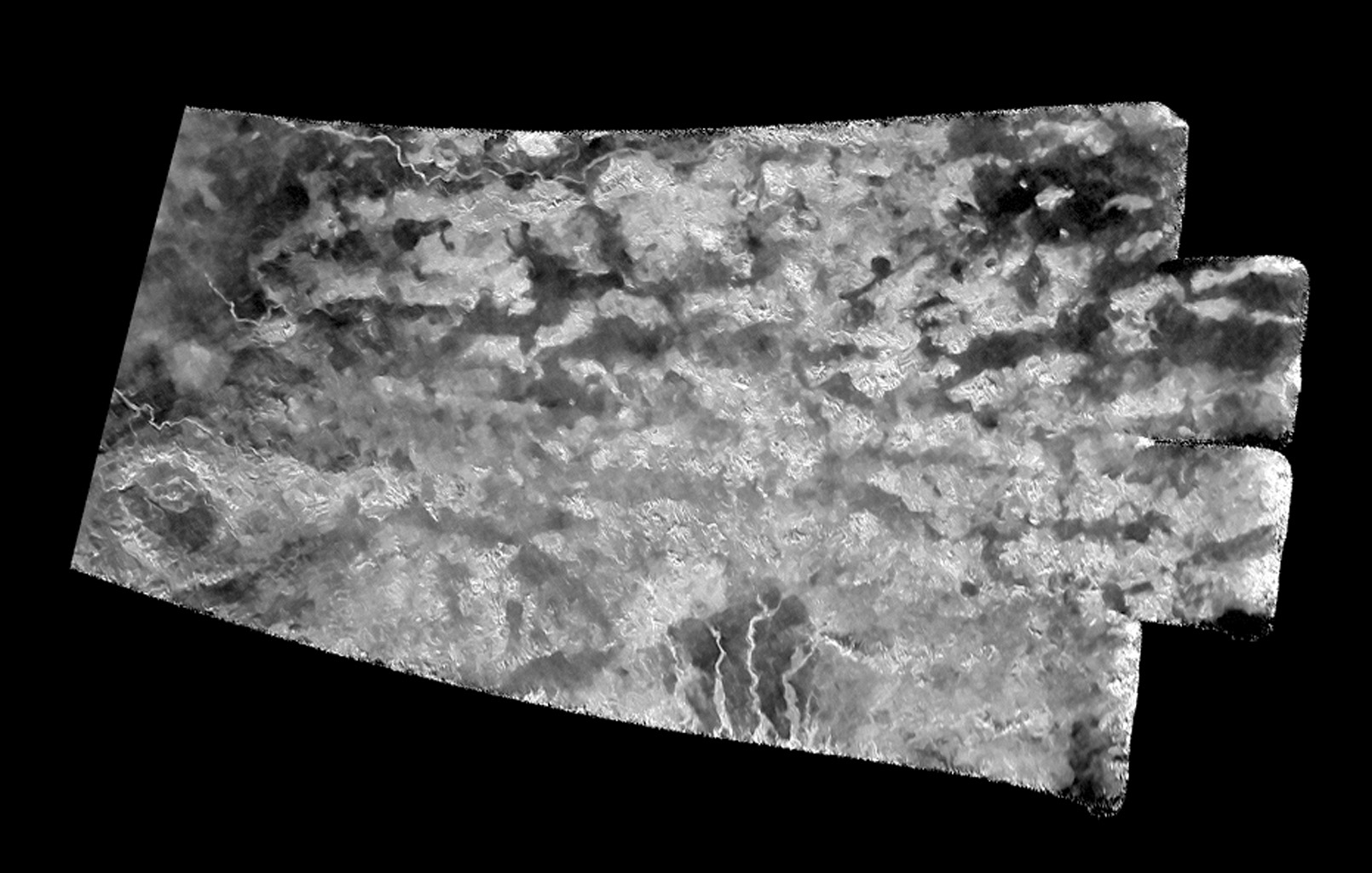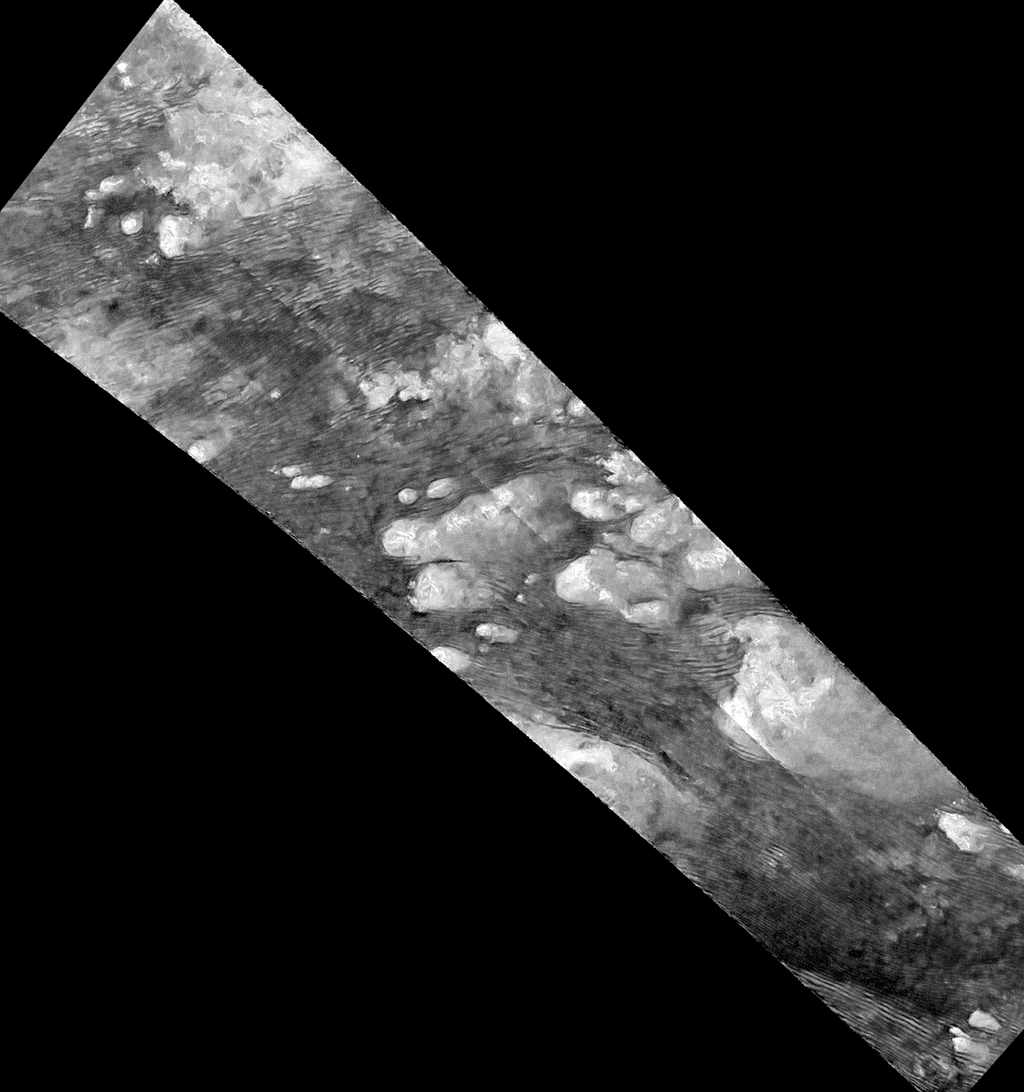'Shangri-La' On Saturn Moon Titan Teeming With Sand Dunes

New close-up photos of Titan, Saturn's biggest moon, show its mysterious and massive dunes in more detail than ever before.
NASA's Cassini orbiter obtained these images when it flew by Titan for the 122nd time on July 25, 2016. The spacecraft was just 607 miles (976 kilometers) above the alien moon's southern hemisphere, according to NASA officials.
The new images include an area called the "Shangri-La Sand Sea," a large dark region with hundreds of long and linear sand dunes. A part of this region had been imaged before, but the new image covers more ground and in greater detail. You can see new video of Titan's 'Shangri-La Sand Sea' by NASA here.
Another image reveals the never-before-seen "Xanadu annex," which lies just south of Xanadu, a region with an Earth-like landscape first imaged by Cassini in 1994. [Amazing Photos: Titan, Saturn's Largest Moon]
Because Titan's atmosphere is thick and hazy, its surface is not easily visible with ordinary cameras. But Cassini comes equipped with a special radar instrument that allows it to see through the obstructing fog by beaming radio waves down to the surface.

Cassini's radio waves bounce off of Titan's surface, and the different ground features reflect the waves back at Cassini with different timing and slightly altered wavelengths. By recording these changes to the radio waves, Cassini's radar instrument can construct an image of the landscapes beneath Titan's atmosphere.
Titan's surface is teeming with dunes similar to sand dunes here on Earth, but they aren't made of silicates like our sand. Instead, Titan's sand contains grainy hydrocarbons that formed in its atmosphere before precipitating onto the ground.
Get the Space.com Newsletter
Breaking space news, the latest updates on rocket launches, skywatching events and more!

The dunes reach heights of more than 300 feet (91 meters), which is gigantic compared to average sand dunes on Earth. Their structures can reveal information about Titan's surface topography and wind patterns. [Titan Sand Dunes Reveal Clues of Saturn Moon's Past]
"Dunes are dynamic features. They're deflected by obstacles along the downwind path, often making beautiful, undulating patterns," Jani Radebaugh, a Cassini radar team associate at Brigham Young University in Provo, Utah, said in a statement.
These new images of Titan's southern terrain will also be Cassini's last. The spacecraft will spend the remainder of its mission checking out lakes and seas in the north. After four more flybys of Saturn's giant moon, Cassini will end its mission by plunging straight into Saturn's atmosphere.
Email Hanneke Weitering at hweitering@space.com or follow her @hannekescience. Follow us @Spacedotcom, Facebook and Google+. Original article on Space.com.
Join our Space Forums to keep talking space on the latest missions, night sky and more! And if you have a news tip, correction or comment, let us know at: community@space.com.

Hanneke Weitering is a multimedia journalist in the Pacific Northwest reporting on the future of aviation at FutureFlight.aero and Aviation International News and was previously the Editor for Spaceflight and Astronomy news here at Space.com. As an editor with over 10 years of experience in science journalism she has previously written for Scholastic Classroom Magazines, MedPage Today and The Joint Institute for Computational Sciences at Oak Ridge National Laboratory. After studying physics at the University of Tennessee in her hometown of Knoxville, she earned her graduate degree in Science, Health and Environmental Reporting (SHERP) from New York University. Hanneke joined the Space.com team in 2016 as a staff writer and producer, covering topics including spaceflight and astronomy. She currently lives in Seattle, home of the Space Needle, with her cat and two snakes. In her spare time, Hanneke enjoys exploring the Rocky Mountains, basking in nature and looking for dark skies to gaze at the cosmos.
We finally have a release date for ‘The Alters’, the sci-fi survival game where you team up with your clones to survive a planet on fire (video)
April's Full Pink Moon captivates skywatchers worldwide with dazzling 'micromoon' show (photos)
Axiom Space to launch its 1st orbiting data centers this year









